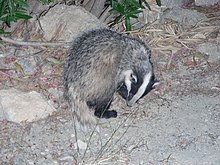Caucasian badger
| Caucasian badger | |
|---|---|
 | |
| Scientific classification | |
| Domain: | Eukaryota |
| Kingdom: | Animalia |
| Phylum: | Chordata |
| Class: | Mammalia |
| Order: | Carnivora |
| Family: | Mustelidae |
| Genus: | Meles |
| Species: | M. canescens |
| Binomial name | |
| Meles canescens Blanford, 1875 | |
 | |
| European badger range (also includes Caucasian badger range) | |
The Caucasian badger (Meles canescens) or Southwest Asian badger is a species of badger native to Western Asia and some islands in the Mediterranean Sea.
Taxonomy
[edit]The Caucasian badger was formerly thought to be a subspecies of the European badger (M. meles), along with the other subspecies also classified within it. However, a 2013 study found significant genetic divergence between both species. It is thought that both diverged during the Pleistocene, between 2.37 million years ago to 450,000 years ago.[1] The American Society of Mammalogists recognises it as a distinct species.[2]
Description
[edit]This species is smaller than the European badger, with a dirty-greyish back and brown highlights; its head is identical to the European badger, though with weaker crests; its upper molars are elongated in a similar way as the Asian badger's. Its fur can be distinguished from the Asian and Japanese badgers by its facial mask, which resembles that of the European badger.[1][3]
Distribution
[edit]The Caucasian badger ranges from Anatolia north to the Caucasus Mountains, south to the Levant and west-central Iran, and east through the Tian Shan mountains. It also occurs on the Mediterranean islands of Crete and Rhodes. The boundary of its range to the European badger is thought to be in the North Caucasus, but a clear boundary has not been defined, as both are known to be sympatric in some places, and potential hybrids have been identified.[1] It was also recorded in Afghanistan.[4]
Taxonomy
[edit]Of the eight European badger subspecies recognized in 2005,[5] four are now thought to belong to the Caucasian badger.[1]
| Subspecies | Source | Description | Distribution |
|---|---|---|---|
| Transcaucasian badger (M. c. canescens) | Blanford, 1875[6] minor (Satunin, 1905) ponticus (Blackler, 1916) | A small subspecies with a dirty-greyish back and brown highlights; its head is identical to the common badger, though with weaker crests; its upper molars are elongated in a similar way as the Asian badger's.[3] | Transcaucasia, the Kopet Dag, Turkmenistan, Iran, Afghanistan and Asia Minor |
| Cretan badger (M. c. arcalus) | Miller, 1907[7] | Crete | |
| Rhodes badger (M. c. rhodius) | Festa, 1914[8] | Rhodes | |
| Fergana badger (M. c. severzovi) | Heptner, 1940[9] bokharensis (Petrov,1953) | A small subspecies with a relatively pure, silvery-grey back with no yellow sheen. The head stripes are wide and occupy the whole ear. Its skull exhibits several features which are transitory between the Asian and European badger.[3] | Right tributaries of the Panj and upper Amu Darya rivers, the Pamir-Alay system, the Fergana Valley and adjoining mountains[9] |
References
[edit]- ^ a b c d Abramov, A.V. & Puzachenko, A.Y. (2013). "The taxonomic status of badgers (Mammalia, Mustelidae) from Southwest Asia based on cranial morphometrics, with the redescription of Meles canescens". Zootaxa. 3681 (1): 44–58. doi:10.11646/zootaxa.3681.1.2. PMID 25232583.
- ^ "Meles canescens Blanford, 1875". ASM Mammal Diversity Database. American Society of Mammalogists. Retrieved 2021-06-25.
- ^ a b c Heptner, V.G.; Naumov, N.P. (1992) [1967]. "Badger Meles meles Linnaeus, 1758". Mlekopitajuščie Sovetskogo Soiuza. Moskva: Vysšaia Škola [Mammals of the Soviet Union]. Vol. II, Part 1b. Carnivora (Weasels, Additional Species). Washington DC: Smithsonian Institution and the National Science Foundation. pp. 1232–1282.
- ^ Jahed, N. & Ostrowski, S. (2018). "The first record of the Southwest Asian Badger Meles canescens (Mammalia: Mustelidae) from Afghanistan". Zoology in the Middle East. 64 (2): 185–188. doi:10.1080/09397140.2018.1442303. S2CID 91080222.
- ^ Wozencraft, W. C. (2005). "Species Meles meles". In Wilson, D. E.; Reeder, D. M. (eds.). Mammal Species of the World: A Taxonomic and Geographic Reference (3rd ed.). Johns Hopkins University Press. pp. 611–612. ISBN 978-0-8018-8221-0. OCLC 62265494.
- ^ Blanford, W.T. (1875). "Description of new Mammalia from Persia and Balúchistán". The Annals and Magazine of Natural History; Zoology, Botany, and Geology. 4. 16 (95): 309–313.
- ^ Miller, G.S. (1907). "Some new European Insectivora and Carnivora". The Annals and Magazine of Natural History; Zoology, Botany, and Geology. 7. 20 (99): 389–398.
- ^ Festa, E. (1914). "Escursioni Zoologiche del Dr. Enrico Festa nell'Isola di Rodi. Mammiferi". Bollettino dei Musei di Zoologia ed Anatomia Comparata della R. Università di Torino. 29 (686): 1–21.
- ^ a b Heptner, W.G. (1940). "Eine neue Form des Dachses aus Turkestan" (PDF). Zeitschrift für Säugetierkunde. 15: 224.


 French
French Deutsch
Deutsch